Okay; it’s time to settle this never ending debate and put this conversation to rest.
Is AEO just SEO?
Semantics aside, I put together an exact breakdown of both AEO and SEO. It doesn’t matter what you call it, but it’s important that we understand the key differences, the underlying technology, the measurement stack, and how to optimize for AI search at a growth level.
I understand the allergy to a new acronym (as if we didn’t already have enough of those), but maybe it’s what we need to start rethinking our approach and rewriting the distribution playbook.
The Macro‑Shift: From Blue Links, to Answers, to Actions
Here’s the gist: search is no longer a single destination, nor is it limited to ten blue links on a search engine results page (SERP). The current landscape looks more like this:
- Google still processes over 8.5 billion queries a day, but 58.5 % of US searches now finish without a click—no research needed, as the engine itself supplies the answer.
- Meanwhile, ChatGPT.com now receives 5.2 billion visits a month and OpenAI reports ~800 million weekly active users (a metric that has doubled since six months ago), and confirmed by Sam Altman back in April of 2025.
- AI‑native answer engines such as Perplexity handled 780 million queries in May 2025 alone and are growing 20 % month‑over‑month.
In conjunction with this growth of AI-powered search, the interfaces are becoming agentic—OpenAI’s new ChatGPT Agent can plan, browse, and attempt to execute tasks end‑to‑end, while Google Gemini and Microsoft Copilot are embedding “action buttons” that book, buy and schedule for the user.
The result? The optimization playbook has expanded from “earn the click” (SEO) to “win the citation and power the action” (AEO).
AEO vs. SEO: Definitions
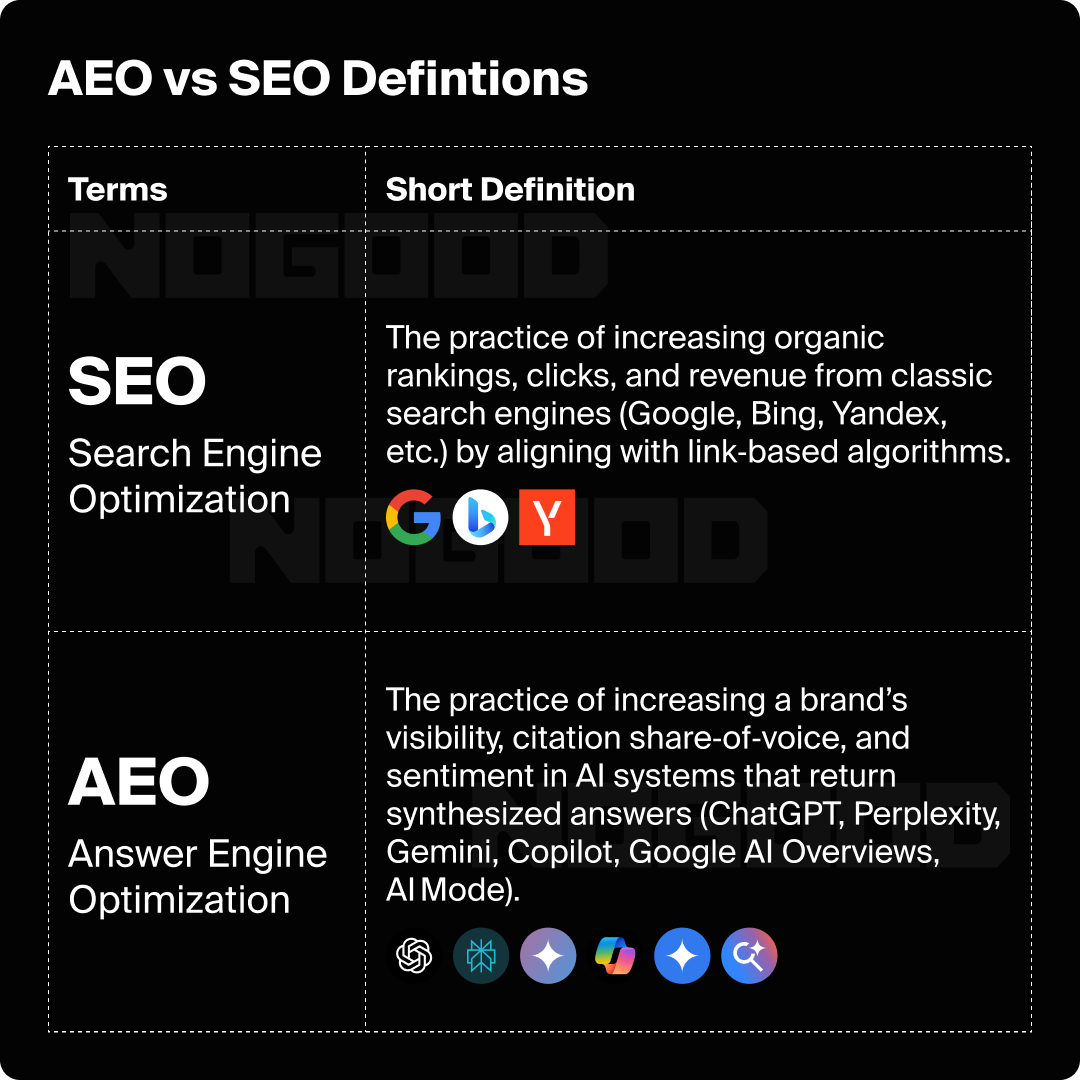
Though the user’s desired action is the same—find an answer to a query, including things like comparing options or making a purchase decision—answer engines operate differently, therefore requiring different optimization tactics than traditional SEO.
While SEOs and marketers are used to collecting top 10 placements on SERPs like Pokémon, AEO is a discipline that focuses on giving the user the answer they are looking for, as well as any auxiliary information (think FAQs and follow-up information), all in one place; and answering the query in the most straightforward way possible. Content that does this well is often cited in LLMs, increasing brand awareness and trust, and informing user purchase decisions.
Let’s take a look at the underlying tech of each engine, as well as how it impacts optimization strategies for SEO vs. AEO.
How the Underlying Tech Differs for SEO & AEO
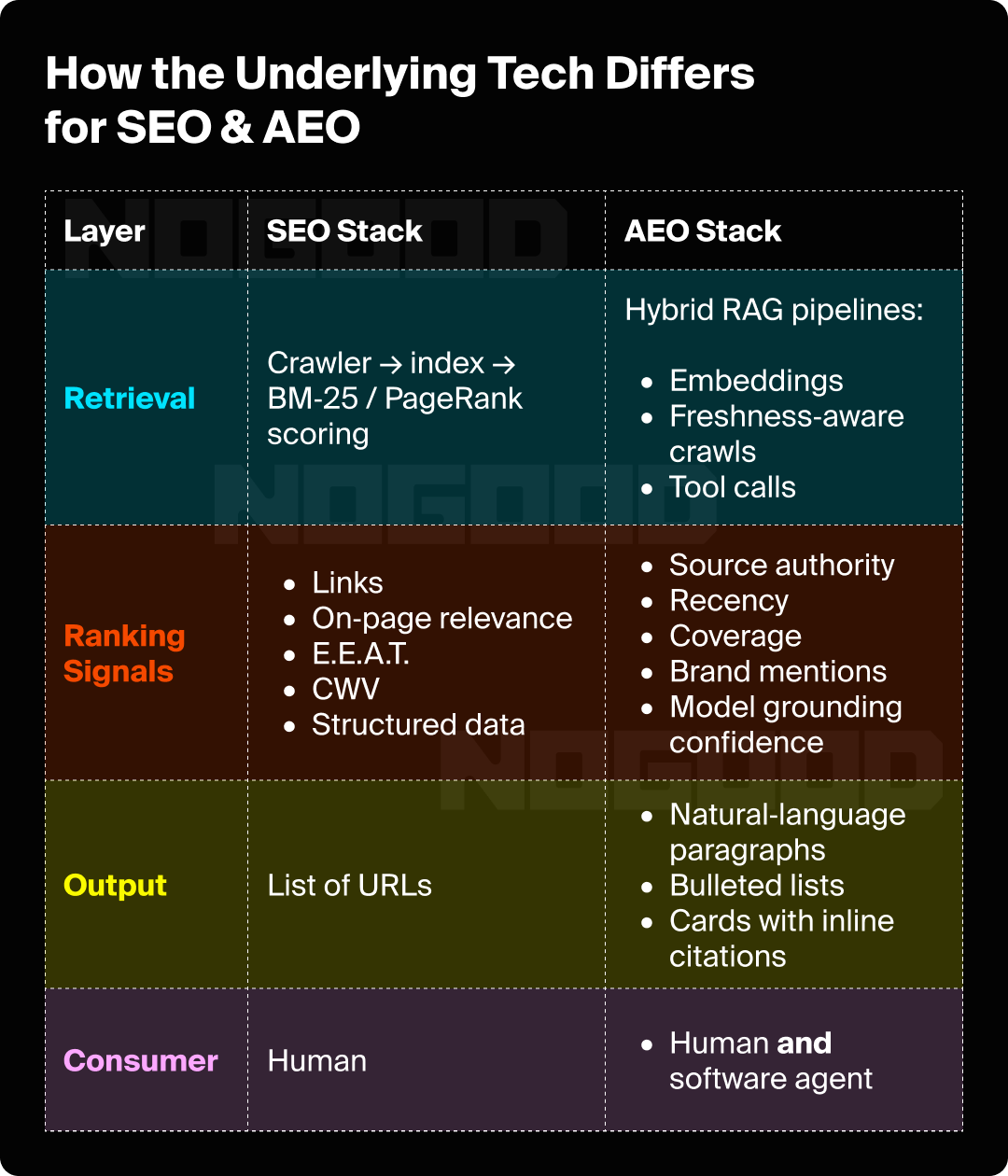
GoogleBot, Google’s crawler system, mostly reads HTML and PDF files (this is how your website is crawled and indexed from a traditional SEO standpoint). LLMs use a similar (albeit less sophisticated or powerful) scraping technique to extract data from websites.
How does this work? To get technical for a second, LLMs.txt allows LLMs to scrape your website just like robots.txt allows GoogleBot and other website analytics tools to crawl it. For developers looking to get more information or get started with LLMs.txt, you can find more information here.
Unlike GoogleBot, however, LLMs can “read” any file type, meaning that schema blocks, FAQs, JSON‑LD and low‑latency APIs often matter more than raw HTML. Brands must therefore think in chunks and snippets that are easy for a model to slot verbatim into an answer.
User Behavior Shift: From Keyword Stubs to Conversational Prompts
To further understand the differences between AEO and SEO, we must also look at how users leverage both types of search modalities. After all, the ultimate goal of both AEO and SEO is to provide users with helpful, trustworthy, and authoritative answers to the queries they input into the engine. Here’s a quick breakdown:
- The average ChatGPT prompt is 23 words, an order of magnitude longer than a Google keyword.
- 34 % of US adults have already tried ChatGPT, up from 14 % just a year prior.
- 57.8 % of users still default to Google when they “need a factual answer,” showing that the two paradigms currently co‑exist.
In practice, people now “search everywhere”: they Google for factual answers and research, they ask ChatGPT when they need a quick, complete answer, they query Perplexity on mobile, they long‑press Gemini inside Android, and they deep-dive and crowdsource information in Reddit threads.
Optimization, therefore, needs to follow the prompt journey, not merely the SERP.
Market Snapshot (Mid‑2025)
To add context to what we’ve covered so far, let’s review the numbers; where are users searching, and how might the latest updates to these engines further spur shifts in the search space?
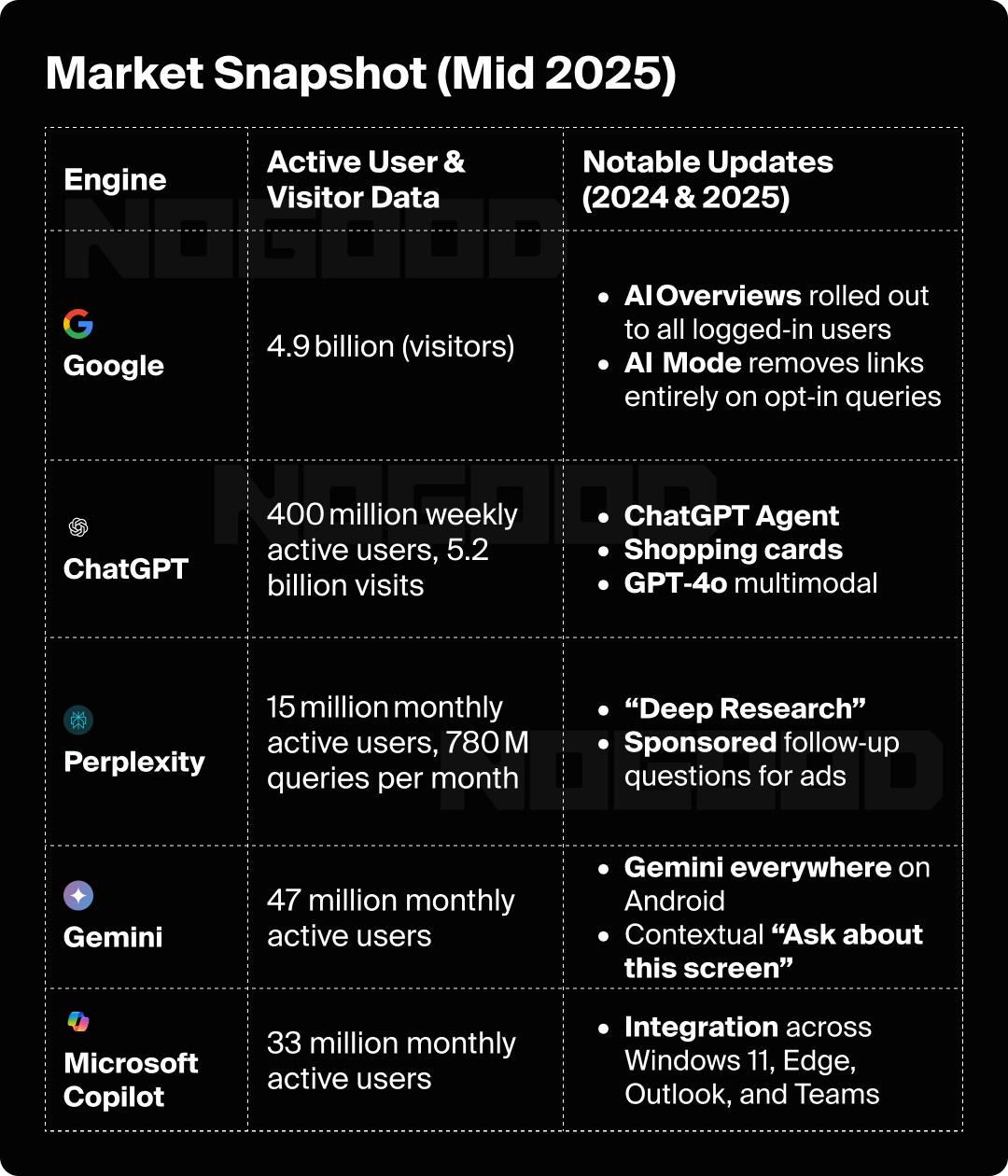
The general trends we’re seeing involve:
- Meeting the user where they are (like embedding AI mode into Google search or Gemini onto Android devices)
- Expanding search capabilities with multimodal search and deep research
- Integration with existing powerful systems (Gemini has been available as an extension of Google Business Suite for a while now, and Microsoft Copilot has since followed suit)
The seemingly obvious next step (one that Perplexity and ChatGPT have already taken, in fact) includes releasing AI search engines to further encroach on Google’s dominance of the search space.
The Surface Is Converging
Classic to Hybrid
Google’s AI Overviews, Bing, and Microsoft Copilot now place the synthesized answer above the traditional organic list. Over 1.5 billion users see an AI Overview each month, and early studies show lower click‑through in healthcare and finance topics.
Hybrid to Agentic
Agentic AI takes artificial intelligence to a new level—rather than interacting with the user on a conversational basis, it acts autonomously to complete tasks with little to no human direction.
OpenAI’s Operator and ChatGPT Agent can already navigate websites, pre-fill forms, and attempt transactions. Gemini has started auto‑adding events to Google Calendar; Copilot plugs into Outlook to draft and send emails autonomously.
The implication? Optimization is no longer just about being seen. Soon, it will be about being the API those agents call.
Measurement Stack: Where Web Analytics Stops
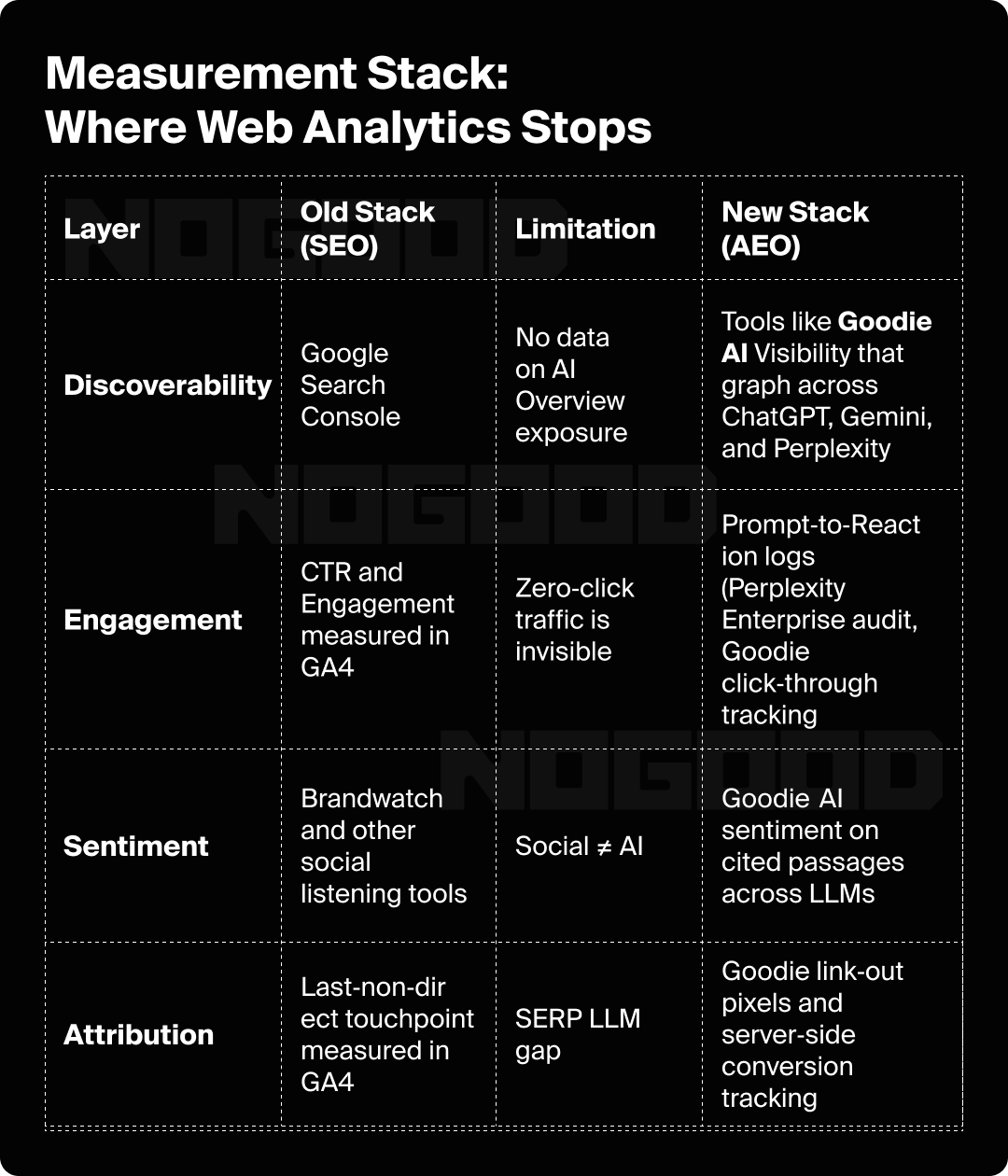
Key Takeaways
- Neither stack replaces the other—rather, they complement each other. Run your traditional measurement stack, like GA4 and GSC, in parallel with AI‑native observability.
- Investing early in tools like Goodie that help you measure sentiment and discoverability is the middle step between optimization and attribution—vet these tools with careful consideration.
- AI attribution will require more specified measurement (asking: how does an AI-generated answer influence a later purchase, even if there’s no direct click?).
AEO Ranking Factors & Optimization Tactics
SEO Essentials (Yes, They’re Still Required)
We’ve established that SEO and AEO play nicely together—here are the traditional SEO components that influence answer engine optimization:
- E.E.A.T.: Demonstrable expertise and author identity. AEO adds another letter to this traditional framework, however—by adding helpfulness, E.E.A.T. becomes H.E.E.A.T.
- Topical Depth: Content should answer a variety of follow-up or related questions stemming from the original topic. Think of this as the evolution of keyword research and clustering.
- Technical Health: Sites must still have a crawlable architecture, CWV, HTTPS, and hreflang.
- Authority: Traditional citations still matter—trustworthy sources must continue to perform and distribute high-quality backlinks and unique data studies.
- Structured Data: If GoogleBot can’t understand your site, neither can LLMs. Apply FAQ, HowTo, Product, and Review schemas to win rich results.
AEO Levers (2025 Edition)
Though maintaining the aforementioned SEO best practices is necessary, AI search is, at the end of the day, a new principle. It involves a few slightly different principles, as well as shifting priorities to align better with AI engines:
Trusted Citations & Brand Mentions
- Why It Matters: Ahrefs found brand mentions the top factor for AI Overview inclusion.
- How to Optimize: Secure expert quotes, participate in threads in niche forums (such as Reddit), review your coverage.
Source Diversity
- Why It Matters: 60% of AI Overview citations come from non‑Google sources (Reddit, TripAdvisor, etc.).
- How to Optimize: Seed discussions in high‑trust communities and syndicate snippets.
Content Chunks & Quotable Copy
- Why It Matters: LLMs are capable of lifting and surfacing 1-3 sentences of content verbatim.
- How to Optimize: Write 40-90 word blocks that answer questions directly and clearly, use bulleted lists in content, list one fact per sentence.
Structured Snippets & JSON-LD API
- Why It Matters: Faster retrieval for RAG (retrieval-augmented generation) pipelines. Essentially, the easier it is for LLMs to retrieve information from your copy, the more likely it is to be surfaced in AI-generated responses.
- How to Optimize: Expose a low‑latency “/facts.json” endpoint, keep timestamps.
Freshness
- Why It Matters: Similar to traditional SEO, AI engines favor new or recently updated pages.
- How to Optimize: Publish consistently and optimize existing content incrementally. Revise timestamps to match the latest content update date.
Robots.txt & LLMs.txt Hygiene
- Why It Matters: Allow helpful scrape to allow LLMs to parse, synthesize, and surface your content. Don’t forget to block out outdated sections to avoid negative freshness signals.
- How to Optimize: Maintain robots.txt files in accordance with site content updates, implement and maintain an LLMs.txt file.
Sentiment & Safety
- Why It Matters: Toxic or conflicting sources get down-weighted.
- How to Optimize: Monitor sentiment reports like those in Goodie closely and correct hallucinations quickly.
SEO vs. AEO? No, SEO + AEO: The Overlap Playbook
Now that we’ve covered the areas where traditional SEO still matters, as well as how AEO builds on these concepts, let’s explore what it could look like to prioritize both disciplines for your optimization strategy:
- Start With Classic SEO Hygiene: Broken links and thin pages still hurt everything. Maintain the health of your website and monitor any errors that are flagged over time.
- Modularize Content: Write with AI content scraping principles in mind. For example, every H2 should be a self‑contained answer that could stand alone in a chatbot.
- Seed Diverse Citations: Publish to your site and cross‑post key facts and original research on partner blogs, Reddit AMAs, SlideShare decks, etc.
- Add Retrieval Endpoints: Having your own lightweight API that returns structured facts gives agents a deterministic source.
- Measure, Iterate, Automate: Set up Goodie AEO dashboards next to GSC so teams see one funnel.
Comparing SEO & AEO at a Glance
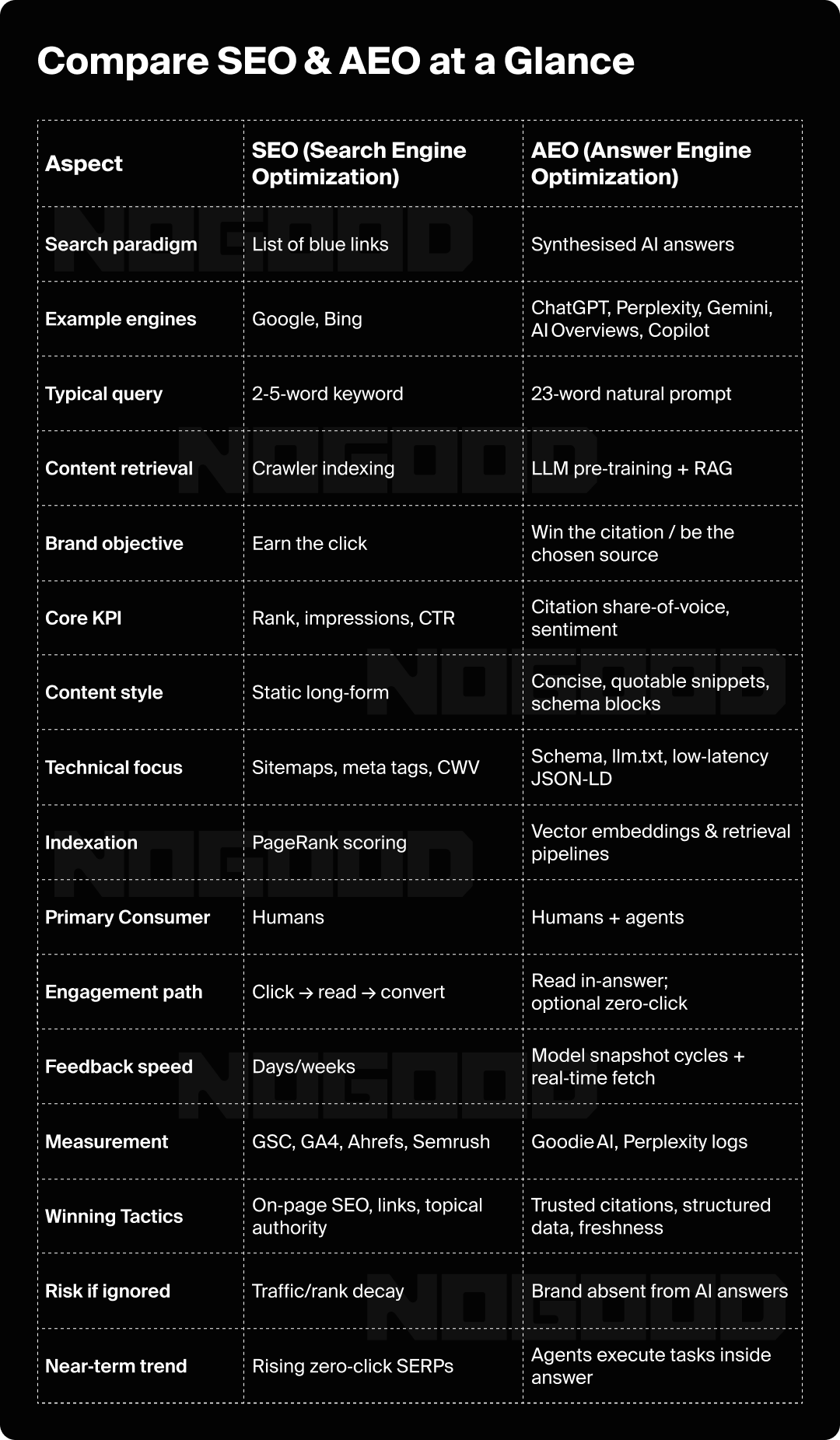
Why SEO Is Still the Foundation for AEO
Search engines feed the LLMs that power answer engines. Pages that rank well, earn backlinks, and accrue engagement supply the training data that ChatGPT and Gemini use to “learn”. Ignoring SEO, therefore, starves AEO.
That being said, the reverse is also true—continuing to optimize for blue links means you are ignoring the fastest‑growing surfaces. Bain & Company projects that up to 25 % of organic traffic could migrate to AI answers by 2026.
Forward‑looking teams treat SEO + AEO as a single lifecycle by:
- Creating Authoritative, Schema‑Rich Content → this content ranks in Google and becomes LLM fodder.
- Amplifying Content Across Trusted, Third-Party Sites → increases the likelihood of multiple citations.
- Monitor Answer Engine Visibility & Iterate Snippets Quickly → using tools like Goodie, uncover and act on insights and recommendations to improve AI visibility.
- Feed Insights Back Into Pillar Pages → this results in higher topical authority and a more optimized crawl budget.
The Next Horizon: Optimization for Agents
As of July 2025, both ChatGPT and Perplexity have announced the release of AI search engines, further extending the capabilities of AI-powered search.
These AI search engines are expected to be able to not only provide answers, but also execute actions (think “book my flight”, “pick the hotel”, or “send the invoice”) ranking factors will extend to tool availability, API latency, and security posture.
Brands that already expose machine‑readable endpoints and clear LLMs.txt permissions will be chosen first—exactly the pattern we saw when Google introduced Featured Snippets in 2014.
AEO vs. SEO: Key Takeaways
Marketers are watching AEO evolve in real-time. So, what do we know to be true already?
- Treat AEO as the inevitable evolution of SEO, not a replacement.
- Structure and snippet‑ize everything (write for copy‑and‑paste by machines).
- Earn mentions beyond your own site (Reddit threads, expert reviews, datasets).
- Instrument AI surfaces with Goodie AI or similar; GA4 alone is blind.
- Prepare for agentic execution (expose APIs and document capabilities in LLMs.txt).
Master these now and your brand will own not only the blue links, but also the answers—and soon, the actions—that shape every customer journey.





